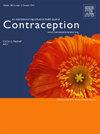Association of Obstetric Comorbidity Index score with postpartum contraception use among Medicaid recipients in the United States
IF 2.3
2区 医学
Q1 OBSTETRICS & GYNECOLOGY
引用次数: 0
Abstract
Objectives
Little is known about postpartum contraceptive use among people at high risk for severe maternal morbidity (SMM). Our objective was to evaluate the association between risk for SMM and postpartum contraceptive use.
Study design
We conducted a retrospective cohort study of live births to Medicaid recipients from 2016 to 2020 across 44 US states. We evaluated the risk for SMM by calculating the Obstetric Comorbidity Index (OCI) scores for each enrollee into lowest risk (OCI = 0) and highest risk (top quartile) groups. We determined the association between the highest quartile OCI score with the use of most or moderately effective postpartum contraception and attendance at outpatient postpartum visits within 60 days. Models adjusted for maternal age, mode of delivery, and comorbidities.
Results
Of 3,342,568 deliveries, 2,474,020 deliveries were associated with an OCI score of 0 (Q0; no risk factors for SMM), while the highest quartile of nonzero OCI scores (Q4) ranged from 13 to 96 (mean risk of SMM 19.7%, SD 7.1) and encompassed 868,548 deliveries. Individuals with the highest risk for SMM were more likely to use postpartum contraception (40.0% vs 32.6%), although after removing sterilization, the difference was modest (32.6% vs 30.1%). There was no meaningful difference in rates of outpatient postpartum visit among people with the highest and lowest OCI scores (46.1% vs 45.6%).
Conclusions
Medicaid recipients with high OCI scores are only slightly more likely to use postpartum contraception as their low-risk peers, and over half will not have outpatient postpartum visit by 60 days.
Implications
Medicaid recipients at high risk for maternal morbidity are only slightly more likely to use postpartum contraception.
美国医疗补助接受者的产科合并症指数评分与产后避孕使用的关系。
目的:对重度产妇发病率(SMM)高危人群产后避孕药使用情况了解甚少。我们的目的是评估严重产妇发病率(SMM)风险与产后避孕药使用之间的关系。研究设计:我们对美国44个州2016年至2020年医疗补助接受者的活产进行了回顾性队列研究。我们通过计算每个入组者的产科合并症指数(OCI)得分来评估SMM的风险,将其分为最低风险组(OCI = 0)和最高风险组(前四分位数)。我们确定了最高四分位数OCI评分与使用最有效或中等有效的产后避孕措施和60天内门诊产后就诊之间的关系。模型根据产妇年龄、分娩方式和合并症进行调整。结果:在3,342,568例分娩中,2,474,020例分娩与OCI评分为0 (Q0;而非零OCI评分(Q4)的最高四分位数范围为13至96 (SMM的平均风险为19.7%,SD为7.1),包括868,548次分娩。SMM风险最高的个体更有可能使用产后避孕措施(40.0%对32.6%),尽管在去除绝育后,差异不大(32.6%对30.1%)。OCI评分最高者和最低者的产后门诊就诊率无显著差异(46.1%对45.6%)。结论:OCI得分高的医疗补助接受者使用产后避孕的可能性仅略高于低风险的同龄人,超过一半的人在产后60天内不会进行门诊。含义:在产妇发病率高风险的医疗补助接受者使用产后避孕的可能性仅略高。
本文章由计算机程序翻译,如有差异,请以英文原文为准。
求助全文
约1分钟内获得全文
求助全文
来源期刊

Contraception
医学-妇产科学
CiteScore
4.70
自引率
17.20%
发文量
211
审稿时长
69 days
期刊介绍:
Contraception has an open access mirror journal Contraception: X, sharing the same aims and scope, editorial team, submission system and rigorous peer review.
The journal Contraception wishes to advance reproductive health through the rapid publication of the best and most interesting new scholarship regarding contraception and related fields such as abortion. The journal welcomes manuscripts from investigators working in the laboratory, clinical and social sciences, as well as public health and health professions education.
 求助内容:
求助内容: 应助结果提醒方式:
应助结果提醒方式:


